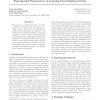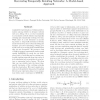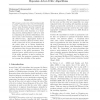92
Voted
ICML
2007
IEEE
16 years 1 months ago
2007
IEEE
Basis functions derived from an undirected graph connecting nearby samples from a Markov decision process (MDP) have proven useful for approximating value functions. The success o...
106
Voted
ICML
2007
IEEE
16 years 1 months ago
2007
IEEE
We present a comprehensive suite of experimentation on the subject of learning from imbalanced data. When classes are imbalanced, many learning algorithms can suffer from the pers...
105
click to vote
ICML
2007
IEEE
16 years 1 months ago
2007
IEEE
The scores returned by support vector machines are often used as a confidence measures in the classification of new examples. However, there is no theoretical argument sustaining ...
ICML
2007
IEEE
16 years 1 months ago
2007
IEEE
Many collective labeling tasks require inference on graphical models where the clique potentials depend only on the number of nodes that get a particular label. We design efficien...
100
Voted
ICML
2007
IEEE
16 years 1 months ago
2007
IEEE
A plausible representation of relational information among entities in dynamic systems such as a living cell or a social community is a stochastic network which is topologically r...
90
Voted
ICML
2007
IEEE
16 years 1 months ago
2007
IEEE
Although each iteration of the popular kMeans clustering heuristic scales well to larger problem sizes, it often requires an unacceptably-high number of iterations to converge to ...
114
Voted
ICML
2007
IEEE
16 years 1 months ago
2007
IEEE
We1 present a new actor-critic learning model in which a Bayesian class of non-parametric critics, using Gaussian process temporal difference learning is used. Such critics model ...
118
Voted
ICML
2007
IEEE
16 years 1 months ago
2007
IEEE
The UCT algorithm learns a value function online using sample-based search. The TD() algorithm can learn a value function offline for the on-policy distribution. We consider three...
104
Voted
ICML
2007
IEEE
16 years 1 months ago
2007
IEEE
Intuitively, learning should be easier when the data points lie on a low-dimensional submanifold of the input space. Recently there has been a growing interest in algorithms that ...
132
click to vote
ICML
2007
IEEE
16 years 1 months ago
2007
IEEE
In this work we take a novel view of nonlinear manifold learning. Usually, manifold learning is formulated in terms of finding an embedding or `unrolling' of a manifold into ...








